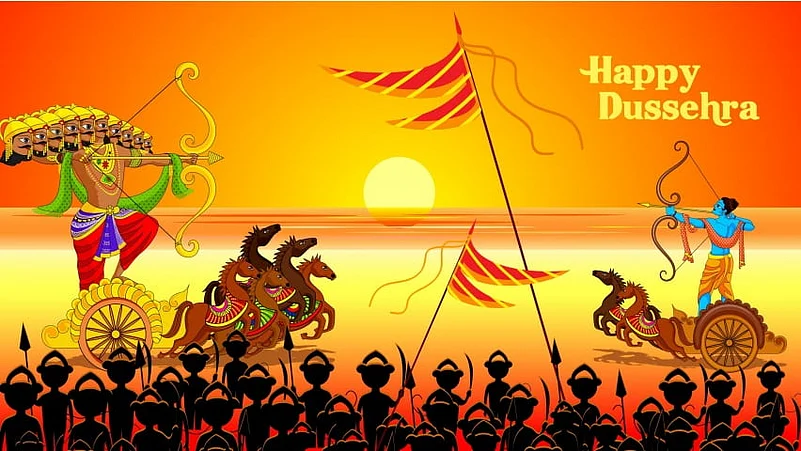Dussehra, the 10th day mark the culmination of the nine-day Navratri and a significant Hindu festival celebrating Lord Rama’s victory over the demon Ravana (one of the great devotees of Lord Shiva). This year the festival will be celebrated on October 12, 2024. Dussehra is one of the grand festivals celebrated across India, with varying traditions, but the essence of the celebration remains the same. The festival holds a crucial place in the hearts of the people of India, as the festival reflects a deep message of ‘Satya Ki Jeet’. Dussehra is also termed Vijayadashmi and signifies the killing of the demon Mahishasura by fierce and brave Mata Durga on the tenth day of the vibrant festival Navratri. Here in this article, we will give details of Vijayadashmi, its history, its rituals, and its timing.
When is Dussehra 2024: date and timing
Dussehra usually falls on the tenth day of Ashwin or Kartik month. This year the grand festival will be celebrated on October 12, 2024. The Dashmi Tithi begins on October 12 at 10:58 am and ends at 9:08 am on October 13, 2024. The Shravana Nakshatra begins on October 12 at 05:25 am and ends on October 13 at 04:27 am. The Vijay muhurta will start on October 12 from 02:03 pm to 02:49 pm, while the Aprahana puja time will begin on October 13 from 01:17 pm to 3:35 pm.
History and significance of Dussehra

Dussehra has its roots in Hindu mythology and is celebrated for two main reasons: one is to commemorate the victory of Lord Rama over the ten-headed demon king Ravana. Ravan abducted Sita (wife of Lord Rama) and kept her in his kingdom, Lanka. After an epic battle and with the help of Vanarsena, Lord Hanuman and Lakshman (brother of Shri Ram), Lord Rama rescues his wife from the clutches of Ravana and kills him. The festival is celebrated to honour this victory and symbolizes the conquest of righteousness over sin.

Another reason is associated with the goddess Durga and the buffalo demon Mahishasur. The tale is related to the festival of Navratri, which culminates in Navratri. The epic battle between Goddess Durga and Mahishasura, where Goddess Durga is often depicted as a warrior goddess, kills the demon Mahishasura and once again proves the victory of good over evil. The victory of goddess Durga also represents the goodness and peace on earth.
Dussehra teaches us a lot; the festival teaches us to follow the path of righteousness and virtue in life. Dussehra signifies the importance of devotion, morality, and perseverance in overcoming challenges, as demonstrated by Lord Rama's dedication to justice and his fight for his wife Sita. Dussehra symbolizes the victory of dharma (righteousness) over adharma (wickedness). The ten heads of Ravana are believed to represent the ten negative qualities of humans, such as anger, ego, greed, jealousy, selfishness, and lust, which must be conquered.
Dussehra in different parts of India: Cultural tradition
Northern India

Ramleela performance: Ramlila, a theatre play or dramatic folk performance, is performed to show how Lord Rama wins over evil Ravana. This play is performed by theatre artists who act for 10 days to depict the epic story. The play consists of several epic stories and dialogues.
Processions: Grand processions are organized where idols of Lord Rama, Sita, Lakshman, and Hanuman are paraded through streets, culminating at the Ram Leela ground where Ravana’s effigy is burned.
Eastern India

Durga Puja Visarjan: The people of eastern India mark the day with great processions to rivers or seas where the idols of goddess Durga are immersed (Visarjana) with the hope that she will come next year. The people of eastern India celebrate the 10th day with teary eyes as they bid farewell to Mata Durga. The Visarjana symbolizes Mata Durga’s return to her celestial abode after defeating the buffalo demon Mahishasura.

Ravan Dahan: In some parts of Bihar, Jharkhand, and Odisha, Ravana Dahan is organized to celebrate Lord Rama’s victory over Ravana. Giant effigies of Ravana are set ablaze in public spaces.
Southern India

Mysore Dussehra: Mysuru or the southern part witnessed Durga Puja as Nadda Habba (state festival) with royal processions, including the famous elephant procession that carries an idol of Goddess Chamundeshwari through the streets of the city. The Mysore place is beautifully decorated with thousands of lights, creating an eye-catching view.
Shami Puja: The Shami (Shani) plants are worshipped by the people in the south during Dussehra. It is believed that worshipping Shami will cleanse the sins and help to defeat enemies.
Western India

Dandiya nights: The celebration of Navratri in western India is full of enthusiasm and joy. They celebrate it by dancing their hearts out. Dandiya and Garba are vibrant folk dances that continue late into the night.
During Dussehra, we not only witness the effigies of Ravana but also our own inner Ravana (greed, anger, ego, disrespect, etc.) burn during the festival. Dussehra is an above festival; it’s a reminder of the eternal battle between good and evil, urging people to conquer negative tendencies and embrace righteousness. Across India, the day is celebrated in diverse yet spiritually connected ways, from the burning of Ravana's effigies to the immersion of Goddess Durga’s idol. Each ritual is infused with symbolism, reminding devotees to uphold virtue, seek victory through moral paths, and strive for a life of balance, success, and prosperity.



























